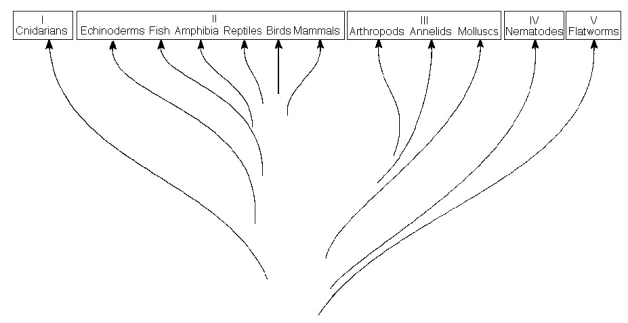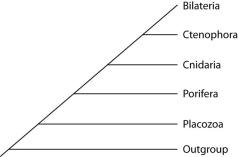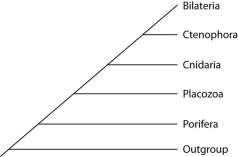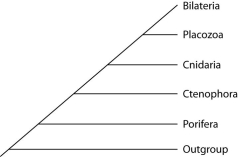A) Radiata should be a true clade.
B) the radial symmetry of extant cnidarians is secondarily derived, rather than being an ancestral trait.
C) Hox genes play little actual role in coding for an animal's "body plan."
D) Cnidaria may someday replace Acoela as the basal bilaterians.
E) Two of the responses above are correct.
Correct Answer

verified
Correct Answer
verified
Multiple Choice
The most recently discovered phylum in the animal kingdom (1995) is the phylum Cycliophora. It includes three species of tiny organisms that live in large numbers on the outsides of the mouthparts and appendages of lobsters. The feeding stage permanently attaches to the lobster via an adhesive disk, and collects scraps of food from its host's feeding by capturing the scraps in a current created by a ring of cilia. The body is sac-like and has a U-shaped intestine that brings the anus close to the mouth. Cycliophorans are eucoelomate, do not molt (though their host does) , and their embryos undergo spiral cleavage. -If harboring large populations of cycliophorans neither helps nor harms their lobster hosts, then cycliophorans can be properly considered to be 1) parasites. 2) mutualists. 3) commensals. 4) symbionts. 5) endosymbionts.
A) 1 and 4
B) 2 and 4
C) 3 and 4
D) 2 and 5
E) 3 and 5
Correct Answer

verified
Correct Answer
verified
Multiple Choice
Some researchers claim that sponge genomes have homeotic genes, but no Hox genes. If true, this finding would
A) strengthen sponges' evolutionary ties to the Eumetazoa.
B) mean that sponges must no longer be classified as animals.
C) confirm the identity of sponges as "basal animals."
D) mean that extinct sponges must have been the last common ancestor of animals and fungi.
E) require sponges to be reclassified as choanoflagellates.
Correct Answer

verified
Correct Answer
verified
Multiple Choice
 The previous figure shows a chart of the animal kingdom set up as a modified phylogenetic tree. Use the diagram to answer the following questions.
-Which of these is the basal group of the Eumetazoa?
The previous figure shows a chart of the animal kingdom set up as a modified phylogenetic tree. Use the diagram to answer the following questions.
-Which of these is the basal group of the Eumetazoa?
A) I
B) II
C) III
D) IV
E) V
Correct Answer

verified
Correct Answer
verified
Multiple Choice
Placozoan evolutionary relationships to other animals are currently unclear, and different phylogenies can be created, depending on the character used to infer relatedness. Sponges have no tissues, but about 20 cell types. Tp (Trichoplax adhaerens) produces a neuropeptide almost identical to one found in cnidarians. The genome of Tp, though the smallest of any known animal, shares many features of complex eumetazoan (even human!) genomes. The next three questions refer to the phylogenetic trees that follow.
I.  II.
II.  III.
III.  -Cycliophorans have two types of larvae. One type of larva-the Prometheus larva-develops into a male. The male, which lacks a digestive system, attaches to the outside of a feeding stage (a female) and impregnates her digestive system, which develops into a different type of larva. What must be true of the digestive system of the feeding-stage female while she is still a virgin?
1) At least some of its cells are haploid.
2) It consists only of highly specialized cells.
3) It is the same size as the male.
-Cycliophorans have two types of larvae. One type of larva-the Prometheus larva-develops into a male. The male, which lacks a digestive system, attaches to the outside of a feeding stage (a female) and impregnates her digestive system, which develops into a different type of larva. What must be true of the digestive system of the feeding-stage female while she is still a virgin?
1) At least some of its cells are haploid.
2) It consists only of highly specialized cells.
3) It is the same size as the male.
A) 1 only
B) 2 only
C) 3 only
D) 1 and 3
E) 2 and 3
Correct Answer

verified
Correct Answer
verified
Multiple Choice
Which of the following statements concerning animal taxonomy is (are) true? 1) Animals are more closely related to plants than to fungi. 2) All animal clades based on body plan have been found to be incorrect. 3) Kingdom Animalia is monophyletic. 4) Only animals reproduce by sexual means. 5) Animals are thought to have evolved from flagellated protists similar to modern choanoflagellates.
A) 5 only
B) 1 and 3
C) 3 and 5
D) 3, 4, and 5
Correct Answer

verified
Correct Answer
verified
Multiple Choice
Protostome characteristics generally include which of the following?
A) a mouth that develops secondarily, and far away from the blastopore
B) radial body symmetry
C) radial cleavage
D) determinate cleavage
E) absence of a body cavity
Correct Answer

verified
Correct Answer
verified
Multiple Choice
According to the evidence collected so far, the animal kingdom is
A) monophyletic.
B) paraphyletic.
C) polyphyletic.
D) euphyletic.
E) multiphyletic.
Correct Answer

verified
Correct Answer
verified
Multiple Choice
You have before you a living organism, which you examine carefully. Which of the following should convince you that the organism is acoelomate?
A) It is triploblastic.
B) It has bilateral symmetry.
C) It possesses sensory structures at its anterior end.
D) Muscular activity of its digestive system distorts the body wall.
Correct Answer

verified
Correct Answer
verified
Multiple Choice
Trichoplax adhaerens (Tp) is the only living species in the phylum Placozoa. Individuals are about 1 mm wide and only 27 μm high, are irregularly shaped, and consist of a total of about 2,000 cells, which are diploid (2n = 12) . There are four types of cells, none of which are nerve or muscle cells, and none of which have cell walls. They move using cilia, and any "edge" can lead. Tp feeds on marine microbes, mostly unicellular green algae, by crawling atop the algae and trapping it between its ventral surface and the substrate. Enzymes are then secreted onto the algae, and the resulting nutrients are absorbed. Tp sperm cells have never been observed, nor have embryos past the 64-cell (blastula) stage. -In an experiment, several Tp individuals were stained different colors. The stained individuals were then passed through a strainer, disaggregated to the level of single cells, and collected into a common container of seawater. Which subsequent finding would be most surprising if the Tp individuals used in this experiment had been produced by sexual, rather than asexual, means?
A) If all of the cells from a given individual reaggregated to form the same individual, and if each cell had retained its original identity, as far as cell type goes.
B) If all of the cells from a given individual reaggregated to form the same individual, but if each cell had a different identity than it had before disaggregation.
C) If cells from different original individuals reaggregated together to form new individual organisms.
D) If cells from different original individuals reaggregated together to form new species.
Correct Answer

verified
Correct Answer
verified
Multiple Choice
What does recent evidence from molecular systematics reveal about the relationship between grades and clades?
A) There is no relationship.
B) Some, but not all, grades reflect evolutionary relatedness.
C) Grades have their basis in, and flow from, clades.
D) Each branch point on a phylogenetic tree is associated with the evolution of a new grade.
Correct Answer

verified
Correct Answer
verified
Multiple Choice
A student encounters an animal embryo at the eight-cell stage. The four smaller cells that comprise one hemisphere of the embryo seem to be rotated 45 degrees and to lie in the grooves between larger, underlying cells (i.e., spiral cleavage) . -This embryo may potentially develop into a(n)
A) turtle.
B) earthworm.
C) sea star.
D) fish.
E) sea urchin.
Correct Answer

verified
Correct Answer
verified
Multiple Choice
A researcher is trying to construct a molecular-based phylogeny of the entire animal kingdom. Assuming that none of the following genes is absolutely conserved, which of the following would be the best choice on which to base the phylogeny?
A) genes involved in chitin synthesis
B) collagen genes
C) β-catenin genes
D) genes involved in eye-lens synthesis
E) genes that cause radial body symmetry
Correct Answer

verified
Correct Answer
verified
Multiple Choice
Phylogenetic trees are best described as
A) true and inerrant statements about evolutionary relationships.
B) hypothetical portrayals of evolutionary relationships.
C) the most accurate representations possible of genetic relationships among taxa.
D) theories of evolution.
E) the closest things to absolute certainty that modern systematics can produce.
Correct Answer

verified
Correct Answer
verified
Multiple Choice
Fossil evidence indicates that the following events occurred in what sequence, from earliest to most recent? 1) Protostomes invade terrestrial environments. 2) Cambrian explosion occurs. 3) Deuterostomes invade terrestrial environments. 4) Vertebrates become top predators in the seas.
A) 2 → 4 → 3 → 1
B) 2 → 1 → 4 → 3
C) 2 → 4 → 1 → 3
D) 2 → 3 → 1 → 4
E) 2 → 1 → 3 → 4
Correct Answer

verified
Correct Answer
verified
Multiple Choice
Placozoan evolutionary relationships to other animals are currently unclear, and different phylogenies can be created, depending on the character used to infer relatedness. Sponges have no tissues, but about 20 cell types. Tp (Trichoplax adhaerens) produces a neuropeptide almost identical to one found in cnidarians. The genome of Tp, though the smallest of any known animal, shares many features of complex eumetazoan (even human!) genomes. The next three questions refer to the phylogenetic trees that follow.
I.  II.
II.  III.
III.  -Which phylogeny has been created by emphasizing a protein found in placozoans?
-Which phylogeny has been created by emphasizing a protein found in placozoans?
A) I
B) II
C) III
Correct Answer

verified
Correct Answer
verified
Multiple Choice
If the current molecular evidence regarding animal origins is well-substantiated in the future, then what will be true of any contrary evidence regarding the origin of animals derived from the fossil record?
A) The contrary fossil evidence will be seen as a hoax.
B) The fossil evidence will be understood to have been incorrect because it is incomplete.
C) The fossil record will henceforth be ignored.
D) Phylogenies involving even the smallest bit of fossil evidence will need to be discarded.
E) Only phylogenies based solely on fossil evidence will need to be discarded.
Correct Answer

verified
Correct Answer
verified
Multiple Choice
Both animals and fungi are heterotrophic. What distinguishes animal heterotrophy from fungal heterotrophy is that only animals derive their nutrition by
A) preying on animals.
B) ingesting it.
C) consuming living, rather than dead, prey.
D) using enzymes to digest their food.
Correct Answer

verified
Correct Answer
verified
Multiple Choice
What is true of the clade Ecdysozoa?
A) It includes all animals that molt at some time during their lives.
B) It includes all animals that undergo metamorphosis at some time during their lives.
C) It includes all animals that have body cavities known as pseudocoeloms.
D) It includes all animals with genetic similarities that are shared with no other animals.
E) It includes all animals in the former clade Protostomia that truly do have protostome development.
Correct Answer

verified
Correct Answer
verified
Multiple Choice
The most recently discovered phylum in the animal kingdom (1995) is the phylum Cycliophora. It includes three species of tiny organisms that live in large numbers on the outsides of the mouthparts and appendages of lobsters. The feeding stage permanently attaches to the lobster via an adhesive disk, and collects scraps of food from its host's feeding by capturing the scraps in a current created by a ring of cilia. The body is sac-like and has a U-shaped intestine that brings the anus close to the mouth. Cycliophorans are eucoelomate, do not molt (though their host does) , and their embryos undergo spiral cleavage. -Cycliophorans have two types of larvae. One type of larva is produced when the digestive system of a female is impregnated by a male. The digestive system then collapses and develops into a larva, which swims away in search of a new host after the surrounding female dies. Which is the embryonic tissue that is apparently most important in forming this type of larva?
A) mesohyl
B) mesoderm
C) ectoderm
D) endoderm
E) mesoglea
Correct Answer

verified
Correct Answer
verified
Showing 21 - 40 of 74
Related Exams